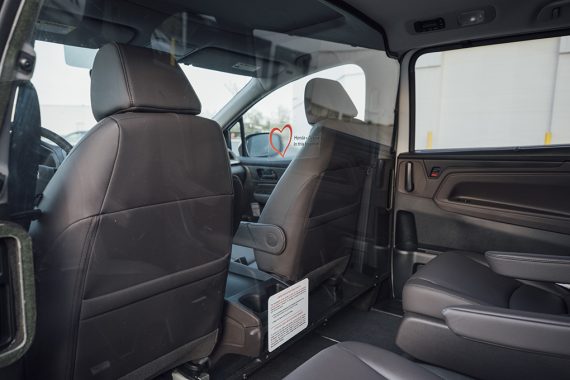Detroit-area Residents will be Transported to COVID-19 Testing in Modified Honda Odyssey Minivans
On May 5, Honda delivered 10 Odyssey minivans to the City of Detroit that have been specially outfitted to transport people potentially infected with COVID-19, as well as healthcare workers. To protect the health of the driver from the potential for droplet infection during transportation, the Honda Odysseys have been retrofitted with a plastic barrier installed behind the front seating area, as well as modifications to the ventilation system to maintain an air pressure differential between the front and rear seating areas.
After seeing news reports about similar specially equipped vehicles modified by Honda in Japan, officials from the state of Michigan and the City of Detroit approached Honda in the U.S. in mid-April about the possibility of acquiring similar vehicles for use in transporting local residents and healthcare workers to COVID-19 testing. A team of volunteers at Honda’s R&D center in Raymond, Ohio, including senior engineers and fabrication experts, quickly conceived and designed a method to modify the U.S. Odyssey at the Honda R&D Americas vehicle development center in Raymond, Ohio, where it was originally developed.
“As of today, the City of Detroit has tested over 20,000 residents and employees for COVID-19. Transportation is a critical component of ensuring every Detroiter has access to a test. We are very appreciative of Honda for choosing Detroit to deploy these newly modified vehicles,” said Mayor Mike Duggan, City of Detroit.
The team of Honda engineers and experts in Ohio took the project from initial concept to completion in less than two weeks. All material fabrication and installation, and adjustments to the software for the Odyssey’s ventilation system, was done entirely in-house.
“We’re very proud of the efforts made by Honda engineers in Ohio to quickly devise a plan and modify a small fleet of Honda Odyssey minivans to support the people of Detroit in the face of this unprecedented global pandemic,” said Rick Schostek, executive vice president of American Honda Motor Co., Inc. “This project is one of many initiatives being undertaken by Honda and our associates to support communities throughout the country during this very difficult time.”
The Odyssey minivan modified in Japan is a smaller vehicle than the eight-seat U.S. version of the Honda Odyssey that was designed, developed and engineered in the U.S. and is made exclusively at a Honda plant in Lincoln, Alabama.
“Several members of our team have family members or friends working in the medical field to battle COVID-19 or know people who have family members battling COVID-19 infection and this became a very personal challenge to help potential victims and their families,” said Mike Wiseman, senior director for Strategic and Materials Research of Honda R&D Americas, LLC, who led the project. “At Honda, we believe the purpose of technology is to help people and make their lives better and we were humbled to make this commitment to potentially help save lives.”
Odyssey Modification Process:
Honda engineers in Ohio installed a sealed clear polycarbonate (plastic) panel between the front seat compartment and rear two-row seating area by removing the hand grips on the structural roof pillar (B-pillar), behind the first row, replacing it with new brackets to attach the clear panel. A second attachment bracket was fabricated and attached to the lower front seat belt anchor point for a total of three secure attachments on each side.
In conjunction with the installation of the clear polycarbonate barrier, the Odyssey’s ventilation system software was tuned to maintain a more positive pressure zone within the front compartment to establish a designed air pressure differential between the front and rear seating areas, greatly reducing the potential for droplet infection migration during transportation.
Honda R&D engineers in Ohio designed the software that controls the ventilation system on the current-generation Odyssey. This core knowledge enabled engineers to tune the software to assure the air pressure differential is compliant with guidelines established by the Centers for Disease Control and Prevention (CDC) for negative pressure rooms in medical and research facilities. Specifically, the software is tuned to run the blower motor powering the fans in the front seating area faster than the fans for the rear seating area. The resulting air pressure differential creates a more negative pressure chamber in the rear seating area, with rear compartment air exhausted out the vents in the rear of the vehicle.

Ten specially outfitted Honda Odyssey minivans will be used to transport Detroit-area residents and healthcare workers to COVID-19 testing. 
A Honda R&D Americas, Inc. associate in Ohio installs a sealed clear polycarbonate (plastic) barrier that will help protect the driver from potential droplet infection during transportation in a Honda Odyssey specially outfitted to transport Detroit-area residents and healthcare workers.

